Andalusian music .. Learn about the role of "Zriab" and the Maurice in its prosperity in Morocco
The holy month of Ramadan is celebrated on the Muslim Ummah with a mixture of rituals and special customs that accompany the breakfast and suhoor meals, including enjoying Ramadan and Ramadan tents, which are accompanied by musical concerts and family celebrations enjoyed by people along with spirituality, prayer and fasting in this holy month.
As for the arts, each country has its own taste and heritage arts that have not disappeared or disappeared over time, and it still has its audience among new generations, including Andalusian music also known as "machine music", the oldest music heritage in Morocco, The Morissians, following their emigration from Andalusia to the Maghreb, after being developed by Zriab and Ben Beja, continue to enjoy a prominent place in Moroccan society and play in weddings and events in special rituals.
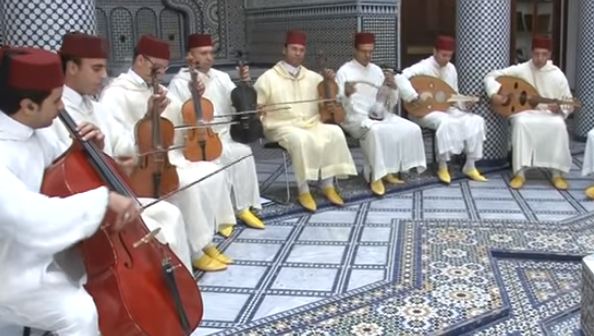
Andalusian music
Origins of Andalusian music
Andalusian music is the result of the mixing of oriental and Maghreb music to a special entity that distinguishes it from Arabic music. In Andalusian Music, Andalusian music is considered one of the extensions and tributaries of Arabic music in its general sense , And talk about it is like talking about a special color of the colors of Arabic music, so it is natural that this music is linked to the same assets that meet the Arab music in general, although it has been unique characteristics and characteristics contributed to various factors in the creation.
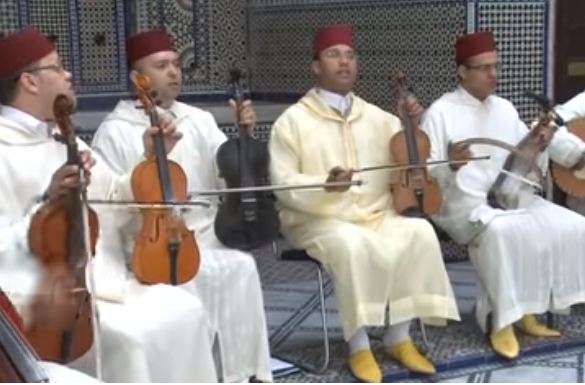
Andalusian music in Morocco
Andalusian Music Abstract Civilizations
He added: "Like all other colors and musical models created by Arab genius in light of the widespread spread of the Islamic Ummah, this music is a synthesis of the technical data stemming from the nature of the music of the human elements in Andalusia, Arabs, Berbers, Goths and Salsabala, and Arabic music in its forms and molds for the pre – Islam and the era of the first Islamic conquests were the essence of what was born in practice in the fields of singing, writing and playing after opening up to the influences of Persian and Hindi, these forms and molds moved to Morocco (the Great) and Andalus with the Arabs The conquerors to carry with them authentic features still clear evidence of its effects today which features preserved Andalusian music character of the Arab although the Iberian Peninsula settled for several centuries have made them always subject to the taste of the Arab. "
"The machine," or what is known as "Andalusian music", as its name indicates, is based on the automatic performance based on the vibrations and the anguish, especially on the manifold, the lute and the rhythm (cadence officer), although this is what Abbas al-Jirari, a Moroccan writer, historian and scholar, Performance is based on poetic texts to adjust its rhythms, especially from the mashahat and azjal, which is an integrated, structured and orderly structure based on shifts, "according to a report in the Independent.
A band playing Andalusian music
Moroccan band playing Andalusian music
Muhashat and al-Zajil
"Al-Muhashah is a poetic poem, but it is not subject to the unity of the house nor is it subject to the unity of the rhyme, but it is divided into sections or sections, some of which are called Some of which are called "abyata". This system, which is followed by the mashahh, requires that the mashahaha be based on a set of locks and a set of parts. The locks are similar in weight and similar in rhyme. The verses are similar in weight between them and different in terms of rhyme, As for the zajal, it is the same as the one with one difference And in the colloquial language, he was also subject to singing and the requirements of this singing and performance bowed, "while Andalusian music to blend music and singing Muashahat in a special order called" Nubia. "
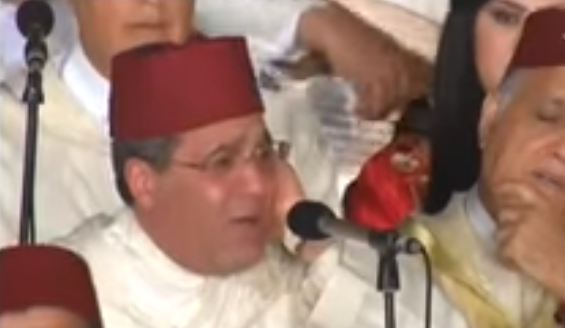
Mushat and Zajal in Andalusian music
"Nubia" and Mahdi bin Jaafar al-Mansur
The origin of the word "Nuba" to the era of Caliph Abbasi Mahadi bin Jaafar al-Mansur (785-775), as he was allocated a day for each area of thought and art, and supervised himself competitions, was said, for example, "Today's bout singing" Until the word became concerned during the reign of Caliph Haroun al-Rashid (809-786) time allotted to each singer before the caliph.
Dr. Al-Girari explained that "Nubia is the sum of the pieces, parties or parts that make music performance within a specific range. This work is integrated. It means a collection of pieces, melodies and melodies, some of which complement each other. Settled in Andalusia and was associated with Andalusian music, as Nuba is a basic tonal component, these fits fit different times of man over the days and seasons.
He added that some of these seizures were lost because they were based on the basic element is improvisation, which is almost a key feature of Andalusian music, which moved to Europe and others, and the number of shifts 24 hours per day, corresponds to every hour of the hour and hours only enrich that hour It has been approved, 11 of them in Morocco, 13 in Tunisia and 16 in Algeria.
Performed by Andalusian music
Typology and typography in Andalusian music
Abdel-Jalil says that Idriss Idrissi in his book "The Musical Choices" is almost unique in presenting an initial attempt to define "print" in Andalusian music as "part of the 24-part ritual, and of course he is of the opinion that he agrees with human nature."
"It seems that the connection between typhus and printing came to reflect the echoes of a theory whose origins may be attributed to the era of the philosophers of Greece and then moved to the Arabs through what they translated from those, and then spread in the books of the first philosophers of Islam such as Canadians and Farabi and Ben Sena, and then spread the spread of knowledge and theories And the land of Morocco and Andalusia has become a breeding ground for the promotion of the theory of the relationship between nature and nature. "
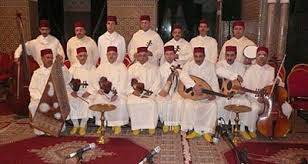
Andalusian Music Ensemble in Morocco
Genius of Zriab
Abulhassan Ali Ben Nafie, known as Zriab, born in Iraq in 777, was a disciple of the Haroun al-Rashid court musician Ishaq al-Musalli until he became proficient in the origins of music and singing. The caliph asked the choir to give him a new melody. Zerayab, and then Harun al-Rashid impressively impressed the father of Hassan in singing and his rich artistic culture, which aroused the hatred of his teacher until he threatened to assassinate him if he did not leave Baghdad.
Zerayab emigrated to Cordoba in Andalusia in 822 after passing through some cities such as Kairouan, the capital of the Aghlabid, but their emir, the first increase of God (816-837), expelled him when he sang a poem of impotence to Abassi, who was considered an insult by the Caliph. Abderrahmane II, who was impressed by his technical level to make it from his entourage, and knew Zriab elegance and elegance and a significant impact in the lives of Andalusians, as they learned a lot of aspects of the art of living, and many of their habits in dress, cleanliness and eating, even said it took them from the life of Badawi to Civilization.
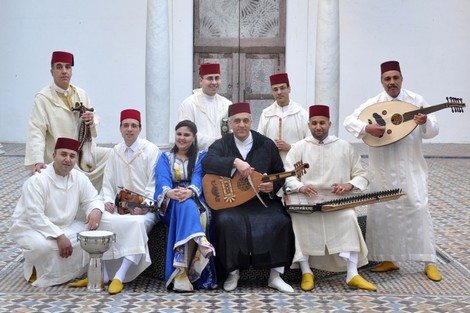
Andalusian music teams in Morocco
Zriab first introduced earthly music into Europe
He founded the first Islamic music school in Cordoba in 825. Some historical sources say that the school, in addition to Arab Muslims, received students from various European countries who returned to their countries of origin, the origins of Arabic music and its machines, which was considered the basis of the European artistic revolution in the era Renaissance, and Zriab was the first to introduce mundane music to Europe, which was then known only as religious music, which was played in churches.
He also introduced several modifications to the music field in Andalusia. He added the fifth string of the Oud instrument. He first introduced the machine into Andalusia, which became the main instrument in western Europe until it invented other instruments such as piano in the beginning of the 18th century. The eagles' feathers replaced the wood, adding new musical compositions that were not previously known. In addition, he invented the method of opening songs instead of musical melodies. He also considered the founder of the artistic foundations of the art of the mashahat. Zriab continued to develop music until he died in Cordoba in 845.
In addition to the influence of Zriab, Dr. El-Girari, the virtues of the codification and control of Andalusian music, refer to Ibn Bajah. "This music, which is different and different, will be prepared in the fourth century, especially the fifth century, Here is another important station, the station represented by the famous philosopher and music artist Ben Paja, who will sit this music, and will be considered benefiting from what was written by the Farabi and the Canadian in the East, and will be given to this music and fortification in Andalusia, a certain template and a framework, .
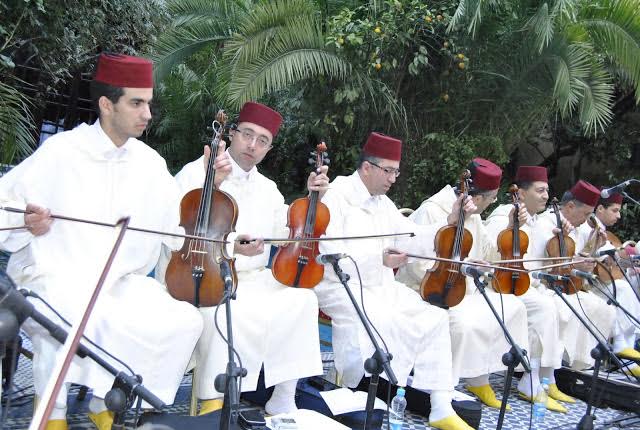
Play violin
The role of the Morissians in the development of Andalusian music
One of the influences on Andalusian music was by the Moriscans, who were Muslims of the Arab-Amazigh European race who settled in the cities of Castile, Valencia, Aragon and Granada, and suffered centuries of persecution and killing since the beginning of the weakness of the Islamic caliphate in Andalusia Spanish, resisted the waves of Christianization and suffered from the Inquisition, and some of them were removed from their children exclusively and Christianization through their upbringing in the church, and migrated the Maurice from Andalusia in batches, while some of them remained there who supported and merged into the Spanish society.
After the fall of Granada, the last stronghold of the Islamic Caliphate in Andalusia in 1492, King Philip decided, under the pressure of the Church, to issue the final expulsion of the Moriscans from Andalusia in September 1609, while rejecting all attempts to convert to Christianity. And Tunisia.
"Morocco has received the largest number of forcibly displaced Maurits," said Moroccan historian Mohamed Ben Azzouz. "It is the Arab and Islamic country where there is the largest A proportion of the Maurice families, and there are real Andalucian cities like Tetouan and Chefchaouen. "
Andalusian Music Schools
Finally, there were three schools of Andalusian music, the Sevilla school which flourished in Libya and Tunisia, known as the Malouf, the Granate school which spread in Algeria, the Valencia school that flourished in Morocco, and the Granate school.
Arabic (t) Arabic Music (t) Ramadan (t) الخاميم الرمضانية (t) News of Art (t) Day 7 Plus
Post a Comment